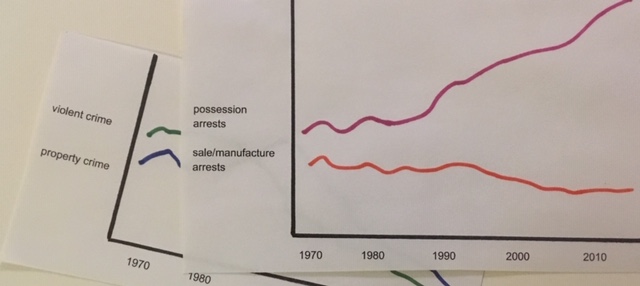Drug War Obscures Decades of Police Success

If I were a cop, I would not be happy about this
In the US these days, discussions about crime are almost never just about crime, it’s always drugs-and-crime, as if referring to a single unified phenomenon, like a dog-and-pony show.
But it was not always this way. In fact, for most of America’s 243 year history, drugs were not illegal (and remember that, for 13 years, alcohol was). Recently, perusing statistics on arrests in the US over the past several decades, I discovered a remarkable thing – other than drug infractions (of which 2/3-4/5th of arrests are not for sales or manufacture, but simple possession), crime has been dropping dramatically in the U.S.
Here’s some numbers from the period 1980-2009, that astonished me:
murder down 51%
forcible rape (not including statutory rape) down 56%
robbery (which was steady between 1980-1996) was down 40% between 1996 and 2009
aggravated assault 1980-1995 increased 75%, but by 2009 declined to 88% below 1980 rate
burglary down 57%
larceny – had ups and downs, but 2009 rate was 17% below 1980 rate
juvenile larceny down 40%
vehicle thefts – rose until 1989, 2009 rate was 71% below 1989’s peak, and 50% below the rate in 1980
weapons violations (manufacture, sale, purchase, transportation, possession, concealment or use of firearms, cutting instruments, explosives, incendiaries, other deadly weapons – including attempts to violate) 2009 rates 46% below 1993 peak, 26% below 1980 level
How about these numbers:
total arrests 1990: 14,195,100
2017: 10,554,985
Down 35%
total population 1990: 248,709,873
total population 2017: 301,230,000
up: 18%
Meanwhile, between 1982-2007 drug arrests rose a great deal – with most of the increase in arrests for simple possession, while arrests for sale/manufacture have remained steady since the end of the 1980s. Adult arrests increased between 1970 and 2007, while arrests of juveniles remained steady. What else happened at the end of the 1980s that may have an impact on drug arrests? Well, for one thing, the first drug court opened in Miami-Dade in 1989. How long would a drug court – or a system of drug courts – last without drug arrests to justify their existence?
One important consideration regarding crimes against persons and property, which have been declining for decades, is that they have victims that complain to the police (with the exception of murder, which has a victim who cannot complain, but whose discovery initiates investigation). This is not the case with “vice” offenses, which are unlikely to be reported to police because the participants are all consenting. This means that if police are to make arrests for vice infractions, they can’t just respond to complaints. They have to engage in investigations, undercover operations, recruit and pay insiders – all activities that are more complicated and expensive than ordinary police operations.
Vice only began to be viewed as a proper target for the criminal justice system in the US in the mid-19th century. The New York Society for the Suppression of Vice, founded in 1875, focused on abortion, pornography, gambling – not drugs or alcohol (although temperance movements opposing alcohol were also part of the 19th century American zeitgeist). But the idea of vice enforcement – using the weight of the criminal justice system to improve the behavior of the lower classes – has, since alcohol prohibition’s repeal, been vigorously applied to drugs, and to a lesser extent, prostitution.
Once we separate out the vice-based prosecution of manufacturers, sellers and users of illegal drugs, it becomes clear that America’s police have been doing a very successful job of making our communities safer for all of us. It is very unfortunate that the drug war, on top of its other failures, has deprived our police of rightful attention to, and appreciation for, the successes their hard work have brought for all of us.
Sourceshttps://www.bjs.gov/content/pub/pdf/aus8009.pdf
US crime arrests 1980-2009
drug arrests sale manufacture- 1980 – 20%, 1991 – 36%, 2009 19%
this means MOST drug arrests are simple posession
https://www.bjs.gov/content/dcf/enforce.cfm
total homicides 1987-2007 (stat for “drug related) went from 17,963 to 14,831
(while population went from 272,650,000 to 301,909,000)
https://www.bjs.gov/content/dcf/enforce.cfm
stats on drug arrests 1982-2007
https://www.statista.com/statistics/191219/reported-violent-crime-rate-in-the-usa-since-1990/
charts of crimes reported 1990-2017 – down down down!, while population has risen
violent crimes down
https://www.statista.com/statistics/191261/number-of-arrests-for-all-offenses-in-the-us-since-1990/
total arrests 1990: 14,195,100 total population 1990; 248,709,873
2017: 10,554,985 total population 2017: 301,230,000
Down 35% Up: 18%
https://ucr.fbi.gov/crime-in-the-u.s/1995/95sec2.pdf
1991-1995 crime going down
http://beatleyweb.simmons.edu/collectionguides/CharitiesCollection/CC009.html
19th century anti-vice activism
https://definitions.uslegal.com/p/public-order-crime/
definition of public order crime “…criminal acts that deviate from society’s general ideas of normal social behavior and moral values….prostitution, paraphilia, pornography, alcohol and drug offenses are public order crimes. Further public order crimes include consensual crimes, victimless vice, [sic]”
New York Society for the Suppression of Vice
https://nyssvhistory.weebly.com/new-york-society-for-the-suppression-of-vice.html
